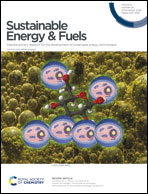A binder-free facile synthetic approach for amorphous, hydrous nickel copper phosphate thin film electrode preparation and its application as a highly stable cathode for hybrid asymmetric supercapacitors†
Abstract
Currently, amorphous, hydrous compounds are receiving much attention as electrodes in hybrid supercapacitors (S.C.s) as they offer extraordinary electrochemical efficiency because of disorder in their structure and an excellent electrochemical interface. In this study, a simple, cost-effective and binder-free synthetic SILAR method is used for preparing amorphous, hydrous nickel copper phosphate (NCP-S) thin film on a stainless steel substrate (S.S.). The amorphous, hydrous NCP-S thin films exhibit mesoporous, clustered spherical particle-like morphology. The optimal ratio (1 : 1) of nickel and copper in the NCP-S (Ni1.56Cu1.44(PO4)2·H2O) material gives a high specific capacitance (Cs) (capacity) of 750 F g−1 (412.50 C g−1) at 1.0 A g−1. More significantly, hybrid asymmetric aqueous S.C. (HAASC) and hybrid all-solid-state asymmetric S.C. (HASASC) electrochemical energy storage devices (ESDs) have been fabricated using NCP-S as a cathode and rGO as an anode. The HAASC device showed a superior Cs (95.62 F g−1 at 3.0 A g−1) with specific energy (S.E.) of 34 W h kg−1 at 2.40 kW kg−1 specific power (S.P.). Additionally, the HASASC device offers higher Cs (37.62 F g−1 at 0.7 A g−1) with 13.51 W h kg−1 S.E. at 0.55 kW kg−1 S.P. Also, both devices exhibit excellent long-term durability (94.11 and 93.81%, respectively, after 5000 GCD cycles). The amorphous, hydrous structures clearly indicate excellent accessibility of ions and stability of electrodes, which is favourable for the hybrid S.C.s. These remarkable supercapacitive results promise the application of amorphous NCP-S as a cathode in commercialized hybrid energy storage systems.



 Please wait while we load your content...
Please wait while we load your content...